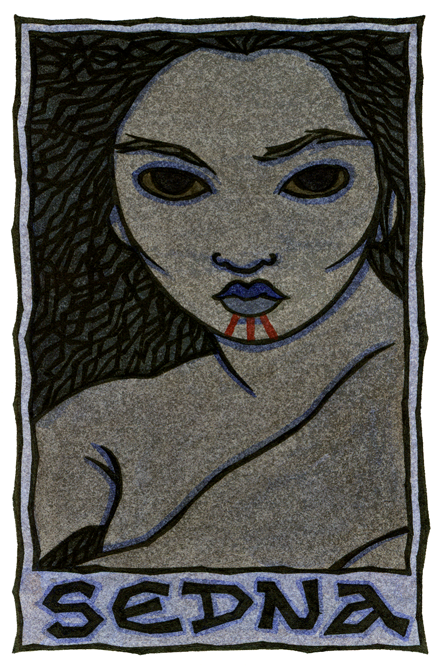 Come to my cold home.
Sedna is the Inuit Goddess of the animals of the Sea, who is considered malevolent to humans, and greatly feared. Offerings are made to Her in an effort to win Her over and ensure plentiful hunting. The word Inuit is often translated simply as "the People;" however the singular form, inua, is the word for "soul" or "spirit," giving it a far richer meaning. Sedna's legend is quite sad: She was the beautiful daughter of a widower and had many suitors, all of whom She refused. Then a handsome hunter came and succeeded in winning Her over, and took Her away to his Land of Birds—for he was actually a kokksaut or petrel-spirit in disguise as a man. When Sedna found out his true nature, She was inconsolable that Her husband was not what he had seemed. In the meantime, Sedna's father, missing Her, made his way to Her new home, and finding Her husband away took his weeping daughter back. Together they set out to their home back across the Sea. But the petrel-husband followed them demanding his wife back. The father refused, and the kokksaut changed into his bird-form, summoning a great storm. In horror and blind panic at having offended the bird-spirit, Sedna's father came to the conclusion that to save himself he must give Sedna as a sacrifice. So he threw his own daughter into the raging Sea. In desperation She grabbed the side of the kayak, but he took an axe and cut Her fingers off to the first knuckles. She clutched the kayak a second and third time, and Her father further mutilated Her hands. Finally She sank beneath the surface and the storm abated. Later the father's tent was swept away by a rare high tide, and he joined his daughter beneath the Sea. Sedna's mutilated hands became the Sea animals--the joints of Her fingers became the salmon, seals and walruses and the rest of Her hands the whales. Sedna is believed to live under the Sea in a house of whale-bones and stones, and rule the realm of Adliden or Adlivin, where the dead go to cleanse themselves of the sins of their lives. Inuit shamans sometimes journey to Her. In the ritual they bring a comb and use it to brush out Her long tangled hair, which She can't do Herself as She no longer has any hands. By soothing Her and treating Her with compassion, they hope to calm Her and gain wisdom. Her Iglulik Inuit equivilant, Takanakapsaluk, like Sedna, receives the dead and causes misfortune, but is known also as a healer who helps hunters. Sedna in a reading indicates deep, buried anger and a feeling of powerlessness. Unacknowledged or disowned anger can lead to depression. However, this anger or buried emotion is in fact very powerful and needs to be accessed, acknowledged or released in a safe manner. Take your cue from the shaman's journey and treat this inner angry person with compassion and soothing gestures. Above all, listen. Sedna is widely worshipped among the Inuit peoples of the polar regions and has many forms and names: Ai-Willi-Ay-O or Aiviliajog; Kannakapfaluk, Arnakapfaluk ("Big Bad Woman") of the Copper Inuit; Idiragijenget for the Central Inuit. She is called Ikalu Nappa in Her form as half-woman, half-fish; Meghetaghna in Siberia; Nerchevik in Labrador; and Nerrivik ("Food Dish") or Nivikkaa ("Woman Thrown Backward Over The Edge") in Greenland. For the Iglulik Inuit of Baffin Island She is Uiniyumayuituq or Unigumisuitok, "The One Who Did Not Want a Husband." This design is available on prints via ArtPal. |